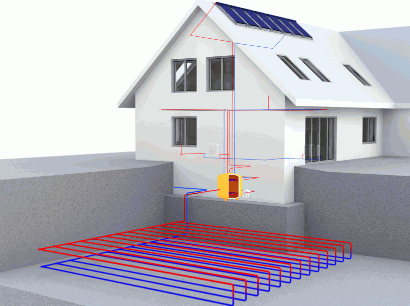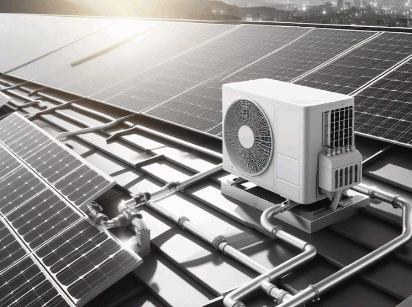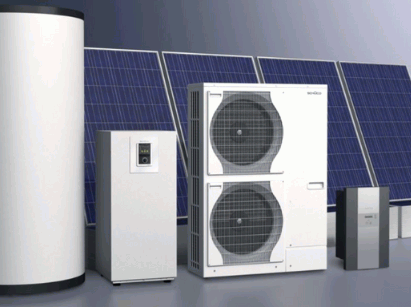With fuel bills soaring and a growing desire to be kind to the environment, it's no wonder that eco-conscious homeowners across Britain are turning to innovative solutions. Two technologies leading the charge are heat pumps and solar panels. But can these renewable energy methods join forces to create an unbeatable energy-saving dream team?
Here at Heat Pump Gang, we're all about empowering you to make informed decisions about your home environment. In this blog, we'll investigate the world of heat pumps and solar panels, exploring whether they work well together to keep your home cosy, reduce your reliance on the national grid, and shrink your carbon footprint.
So, join us as we examine the science behind these technologies, their individual benefits, and the potential for a powerful green partnership.
How Do Heat Pumps Work?
While there are a few different types of heat pumps, they work on the same principle, similar to how your refrigerator operates.
Let's break this down into simple terms:
- Heat Source - It all starts with finding heat, even in cold weather. Air source heat pumps draw heat energy from the outside air, even when it feels chilly to us. Ground source pumps get theirs from the constant warmth below the ground (providing both heating and hot water).
- Heat Transfer - Inside the heat pump, a special liquid refrigerant is circulated. This liquid is good at absorbing heat. As it passes the outside air (or groundwater) in a heat exchanger, it absorbs that heat, turning the liquid into a gas.
- Compression - A compressor then squeezes the gas, and when you compress something, it gets hot! This squeeze concentrates the heat even more in the refrigerant, delivering more heat energy than the amount of electrical energy it uses.
- Delivery - Now the hot refrigerant travels inside to another heat exchanger. There, it warms up the air or water in your home's heating system.
- Cooling Down - Finally, the refrigerant needs to cool down to pick up more heat again. It does this by releasing the pressure and passing through another heat exchanger, which can expel heat back outside in air source pumps.
So, the heat pump doesn't actually create heat, it cleverly moves it from where it's plentiful (outside air or ground) to where you need it (inside your home). This makes them very efficient and eco-friendly!
Gain insights: Heat Pumps For Flats
How Do Solar Panels Work?
There are two basic types of solar panels; solar PV (solar photovoltaic) and solar thermal (although hybrid versions are available that combine the two).
We'll check these out separately to see how they function, and then explore the possibility of using solar power to run your heat pump.
Solar PV Panels
A solar PV panel is covered in tiny solar cells, like little light traps. Here's what happens when the sun shines on them:
- Sunlight & Electrons - Sunlight hits the solar cells, which are made from a conducting material like silicon. This material is special because it allows tiny packets of energy from the sun, called photons, to knock electrons loose from their atoms.
- Flow of Power - These loose electrons start moving through the cell, creating a flow of electricity, just like the current in a battery.
- Direct Current - The electricity produced by solar panels is a type called direct current (DC). This isn't the kind of electricity that powers your appliances directly.
- The Inverter - This converts the DC electricity from the panels into alternating current (AC), which is the kind your home uses, allowing you to power your lights and gadgets with sunshine!
Solar Thermal Panels
Solar thermal panels don't make electricity, but they can heat water very efficiently using the sun's rays.
- Sun Trap - These panels are like mini greenhouses. They trap sunlight inside a special collector.
- Warming Up - Inside the collector, there are tubes filled with a liquid that absorbs heat very well. As sunshine warms the collector, this liquid gets hot too.
- Hot Water Delivery - This hot liquid then travels to a storage tank, where it can be used for things like hot showers or even heating your home's central heating.
So, solar PV turns sunlight into electricity, while solar thermal panels use sunshine to heat water directly. Both are great ways to harness the power of the sun for your home!
Can You Power A Heat Pump With Solar Panels?
The great news is that both air source and ground source heat pumps can be combined with solar panels to create a greener and potentially more cost-effective heating method.
However, the trick is to select the right combination to get the best result.
We’ve explored all the different configurations, and the following examples offer the most benefits in terms of energy efficiency and cost-effectiveness:
Check out: Do Air Source Heat Pumps Work In Winter?
Air Source Heat Pump With Solar PV Panels
This is the most common setup in the UK at the current time. Solar PV generates electricity, which then powers the ASHP. This works well because ASHPs typically use the most electricity during sunnier months when solar panels are most productive.
Benefits
- Simpler installation compared to ground source systems.
- Lower upfront cost.
- Great for areas with good sunlight hours.
Considerations
- May require a larger solar panel array to meet the ASHP's electricity needs, especially in colder climates.
- The efficiency of the ASHP can decrease during the winter months, increasing reliance on the grid.
Ground Source Heat Pump (GSHP) With Solar PV Panels
GSHPs are more efficient than ASHPs, especially in colder climates. However, they also have a higher upfront cost. Pairing them with solar PV can help offset the running costs.
Benefits
- Highly efficient and works well in cold climates.
- A more stable ground temperature provides a consistent heat source.
Considerations
- Requires significant upfront investment for both the GSHP and potentially a larger solar array.
- Installation involves trenching or drilling for the ground loop, which can be disruptive.
Solar Thermal Panels With Heat Pumps (ASHP Or GSHP)
This setup uses solar thermal panels to generate hot water, which can be used directly for heating or to supplement the heat pump.
Benefits
- Can significantly reduce reliance on the grid for hot water.
- Works well in conjunction with both ASHP and GSHP systems.
Considerations
- Requires additional plumbing and a hot water cylinder.
- May not be as effective for space heating compared to using the heat pump directly with solar PV.
The Ideal Choice?
The best configuration for you depends on several factors, including:
- Your climate and typical weather patterns.
- Your budget and available space for solar panels or ground loop installation.
- Your hot water and heating needs.
Heat Pump Gang can help you assess your options and choose the most suitable combination of heat pump and solar panels for your home!
How Many Solar Panels Will I Need?
Unfortunately, there's no easy answer to this question. It depends on various factors that we'll look into here...
It depends on several factors:
- Heat Pump Size - Larger heat pumps (higher kW rating) require more electricity to run, so you'll need more solar panels to power them.
- Climate - Places with colder winters will require the heat pump to work harder, meaning you'll need more solar panel capacity to keep up with the demand.
- Sun Exposure - Areas with more sunshine hours per day will naturally generate more electricity from solar panels, allowing you to potentially use fewer panels compared to a location with less sunlight.
- Household Electricity Usage - If your solar panels are also powering your entire home's electricity needs on top of the heat pump, you'll need a significantly larger system.
However, as a rough guide, an average UK home with a moderately sized heat pump (around 5 kW heat output) might require somewhere between 9 and 13 solar panels.
Realistically, the number of panels needed can vary widely, from as few as 1 to as many as 42, depending on the factors mentioned above.
Important Considerations:
- Solar Battery Storage - Even with a good number of panels, solar energy isn't available at night. To fully power your heat pump around the clock with solar, you might need a battery system to capture excess electricity during the day for use at night.
- Grid Backup - There will likely be times when you need to rely on the grid for backup power, especially on cloudy days or during peak heating periods.
As you can see, it's imperative to consult with a qualified solar panel installer, like Heat Pump Gang, who can assess your specific situation, including your home's energy usage, roof space, and local climate. We can then recommend the most suitable size and configuration for your heat pump and solar panel system.
Is It Worth Combining Heat Pumps And Solar Panels?
If you're looking for a way to avoid rising gas and electricity bills, and you want to reduce your environmental impact, then this is definitely a good move!
However, it must be viewed from a long-term perspective, as the upfront investment can be significant.
So, how much does a combined solar panel and heat pump cost? On average, you're looking at around £6,000, although it depends on the size of the heat pump and how many solar panels are fitted.
Before going ahead, take a moment to consider these points...
Take a look: Geothermal Energy Pros And Cons
The Benefits
- Reduced Energy Bills - Solar panels generate clean electricity that can significantly offset the running costs of your heat pump, potentially helping you save money on your energy bill.
- Environmental Impact - Both your heat pump and solar panels are renewable energy sources, meaning you'll be reducing your carbon footprint and contributing to a cleaner environment.
- Increased Property Value - Homes with energy-efficient features like solar panels and heat pumps can be more attractive to potential buyers and may command a higher price.
- Selling Excess Energy - The Smart Export Scheme pays consumers for generating electricity, so you could sell any surplus energy generated by your solar panels (although you'll need a storage battery for this).
Costs
- Upfront Investment - Installing both a heat pump and solar panel system can require a significant investment. However, government grants and potential savings can offset the cost.
- Operational Costs - Both systems require regular maintenance, though generally minimal.
- Battery Storage (Optional) - To fully power your heat pump twenty-four hours a day with solar, you might need a battery storage system, which adds significant cost to the initial investment.
The Verdict?
Combining solar panels and heat pumps can be a fantastic way to create a more sustainable and potentially cost-effective heating system for your home.
Heat Pump Gang can design a heat pump and solar system to suit your circumstances, calculate how much energy and how many solar panels are required, and ensure that you have all the electricity you need and enough heat when the weather turns cooler.
It's an ideal way to become energy-independent and take control of your future, both financially and in terms of carbon emissions. If this has piqued your interest, contact Heat Pump Gang for more information!











